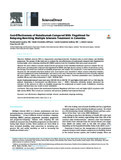| dc.rights.licence | Atribución-NoComercial 4.0 Internacional | * |
| dc.contributor.author | Lasalvia, Pieralessandro | |
| dc.contributor.author | Hernández, Fabián | |
| dc.contributor.author | Castañeda-Cardona, Camilo | |
| dc.contributor.author | Cuestas, Andrés | |
| dc.contributor.author | Rosselli, Diego | |
| dc.coverage.spatial | Colombia | spa |
| dc.date.accessioned | 2020-09-17T00:23:53Z | |
| dc.date.available | 2020-09-17T00:23:53Z | |
| dc.date.created | 2020-01-28 | |
| dc.identifier | https://www-sciencedirect-com.ezproxy.javeriana.edu.co/science/article/pii/S2212109919306272?via%3Dihub | spa |
| dc.identifier.issn | 2212-11028 / 2212-1099 (Electrónico) | spa |
| dc.identifier.uri | http://hdl.handle.net/10554/51082 | |
| dc.format | PDF | spa |
| dc.format.mimetype | application/pdf | spa |
| dc.language | Inglés | spa |
| dc.rights.uri | http://creativecommons.org/licenses/by-nc/4.0/ | * |
| dc.source | Value in Health Regional Issues; Vol. 23 (2020) | spa |
| dc.title | Cost-Effectiveness of Natalizumab Compared With Fingolimod for Relapsing-Remitting Multiple Sclerosis Treatment in Colombia | spa |
| dc.type | info:eu-repo/semantics/article | |
| dc.type.hasversion | http://purl.org/coar/version/c_ab4af688f83e57aa | |
| dc.description.quartilescopus | Q1 | spa |
| dc.identifier.doi | https://doi.org/10.1016/j.vhri.2019.08.481 | spa |
| dc.description.tipoarticulo | Artículo completo | spa |
| dc.description.paginas | 13-18 | spa |
| dc.format.soporte | Electrónico | spa |
| dc.subject.keyword | Cost-effectiveness | spa |
| dc.subject.keyword | Fingolimod | spa |
| dc.subject.keyword | Multiple sclerosis | spa |
| dc.subject.keyword | Natalizumab | spa |
| dc.subject.keyword | Relapsing-remitting | spa |
| dc.description.abstractenglish | Objectives: Multiple sclerosis (MS) is a degenerative neurological disorder. Treatment aims to avoid relapses and disability
progression. The purpose of this study was to evaluate the cost-effectiveness of natalizumab compared with fingolimod for
treating highly active relapsing-remitting MS (RRMS) patients from the Colombian third-party payer perspective.
Methods: We used a Markov economic model from the perspective of the Colombian healthcare system to estimate the costeffectiveness of natalizumab compared with fingolimod for RRMS with high disease activity or failure of interferons as firstline therapy. This model was centered on disability progression and relapses. We considered a 5-year time horizon with a 5%
discount rate. We included only direct medical costs. Local experts were consulted to obtain resource utilization estimates,
and local standardized costing methodologies and sources were used. Outcome was considered in terms of quality-adjusted
life-years (QALYs). Utilities were extracted or calculated from the literature. Transition probabilities were calculated from
available efficacy and safety information (1 USD = 3050.98 COP).
Results: Natalizumab showed lower total costs (USD 80 024 vs USD 98 137) and higher QALY yield (3.01 vs 2.94) than fingolimod, dominating it (incremental cost-effectiveness ratio = 2$1861). Univariate sensitivity analysis showcased the
relevance of the measures of effect on disability progression for natalizumab on model results. Probabilistic sensitivity
analysis replicated base-case results in most simulations.
Conclusions: This study showed that natalizumab dominated fingolimod with lower costs and higher QALYs in patients with
high-activity RRMS. These results are consistent with previous published international literature. | spa |
| dc.type.local | Artículo de revista | spa |
| dc.contributor.corporatename | Pontificia Universidad Javeriana. Facultad de Medicina. Departamento de Epidemiología Clínica y Bioestadística | |


